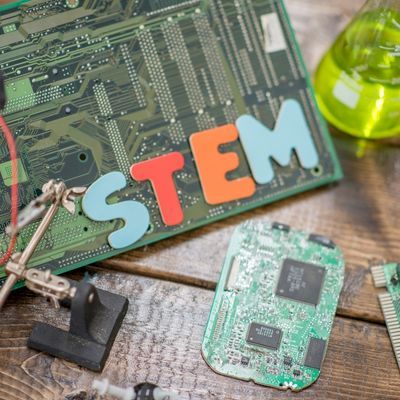Kiddie Academy of St. Louis is excited to share these STEM activities with you and your children in this sponsored post!
We tap into our students’ sense of curiosity by infusing STEM throughout our Life Essentials®curriculum. STEM refers to the integration of Science, Technology, Engineering, and Math skills into meaningful, interactive learning experiences for young children. STEM teaches skills that help children think critically and creatively, solve problems, and discover new concepts on their own.

Your budding scientist, technologist, engineer, or mathematician will love these 3 fun and easy STEM activities to do at home. They’re designed to foster critical thinking through hands-on, play-based, cooperative experiences that use materials you already have at home!
Magnetic Painting: The Fun will Stick with them for Hours!
Materials needed:
● Small magnets (such as magnet wands or magnetic letters/numbers)
● Small bowls or cups
● Washable paint
● White paper
● Cookie sheet or metal tray
● Tape
Instructions:
1 .Tape a piece of white paper to a cookie sheet or metal tray.
2. Pour small amounts of washable paint into small bowls or cups.
3. Place the magnets in the paint bowls and stir them around to coat them with paint.
4. Using the magnet, drag the painted magnet over the paper to create designs and patterns. The paint will move and follow the magnet, creating unique patterns.
5. Experiment with different magnets and paint colors to create different effects and designs.
Tips:
➡️ Use the magnet wand to create larger designs and patterns, and use smaller magnetic letters/numbers to create smaller details.
➡️ Encourage your child to explore and experiment with different patterns and designs.
➡️ Use washable paint to make clean-up easier.
STEM Learning outcomes:
☑️ This activity can help preschoolers develop their creativity and fine motor skills as they use the magnets to create designs and patterns.
☑️ Children will learn about the properties of magnets and how they interact with other objects (like paint).
☑️This activity can also help children learn about cause and effect as they observe how moving the magnet affects the paint.
Balloon Rocket: Launch their Imaginations
Materials needed:
● Balloons
● Drinking straws
● Tape
● String or fishing line
● Scissors
● Marker
Instructions:
1. Cut a piece of string or fishing line to the desired length of your balloon rocket. Make sure it’s long enough to stretch across the room.
2. Tie one end of the string to a sturdy object like a doorknob or chair. The other end should be tied to another sturdy object on the opposite side of the room.
3. Blow up a balloon and then let the air out. This will help stretch the balloon out and make it easier to inflate later.
4. Using a marker, draw a small dot near the opening of the balloon.
5. Cut a drinking straw in half.
6. Tape one end of the straw to the side of the balloon opposite the dot you drew earlier.
7. Thread the string through the straw and hold theballoon at the other end of the string.
8. Blow up the balloon and then let it go. The air rushing out of the balloon will create a force that propels the balloon rocket across the string.
Tips:
➡️ Make sure the string is tight and level so that the balloon rocket can travel smoothly.
➡️ Experiment with different straw lengths and positions to see how they affect the speed and direction of the balloon rocket.
➡️ Try racing two or more balloon rockets at the same time to see which one goes faster or farther.
STEM Learning Outcomes:
☑️ Children will learn about forces and motion as they see how the air rushing out of the balloon propels the rocket forward.
☑️ This activity can also help develop problem-solving skills as children experiment with different straw positions and lengths to improve the performance of their balloon rocket.

Sink or Float: Discover Physics Through Play
Materials needed:
● A large container (like a plastic tub or sink)
● A variety of objects (such as a rubber duck, pencil, rock, feather, plastic toy, sponge, metal spoon, etc.)
● Water
Instructions:
1. Fill the large container with water.
2. Gather a variety of objects and ask your child to predict whether each object will sink or float in the water. Write down their predictions.
3. One by one, place the objects in the water and observe whether they sink or float. Encourage your child to touch and play with the objects.
4. After each object is tested, ask your child whether their prediction was correct or not.
5. Discuss with your child why some objects sink and others float. For example, heavier objects sink because they are denser, while lighter objects float because they are less dense.
6. Have your child choose one or two objects to experiment with. Ask them to make changes to the object, such as adding more weight or making it more buoyant, and predict whether the changes will make the object sink or float.
7. Test the modified objects in the water and see if the predictions were correct.
Tips:
➡️ Encourage your child to use their senses to explore the objects and water, such as feeling the weight of the objects, smelling the water, and listening to the sounds.
➡️ You can also ask open-ended questions to encourage critical thinking and problem-solving skills, such as “What would happen if we added more water to the container?” or “Why do you think the sponge floated even though it’s squishy?”
STEM Learning outcomes:
☑️ This activity can help children develop their observation skills and learn about the properties of objects and water.
☑️ Children will also learn about scientific concepts such as buoyancy and density.
☑️ Encouraging children to make predictions and experiment with modifying objects can help develop their problem-solving and critical thinking skills.
We hope that you will find these STEM activities to be helpful to create experiences for your child that are fun and inspiring!
Kiddie Academy of Chesterfield
196 Hilltown Village Center • 636.778.4888
Kiddie Academy of Des Peres
13133 Manchester Road • 314.394.2800
Kiddie Academy of O’Fallon
4088 Winghaven Boulevard • 636.265.3444















